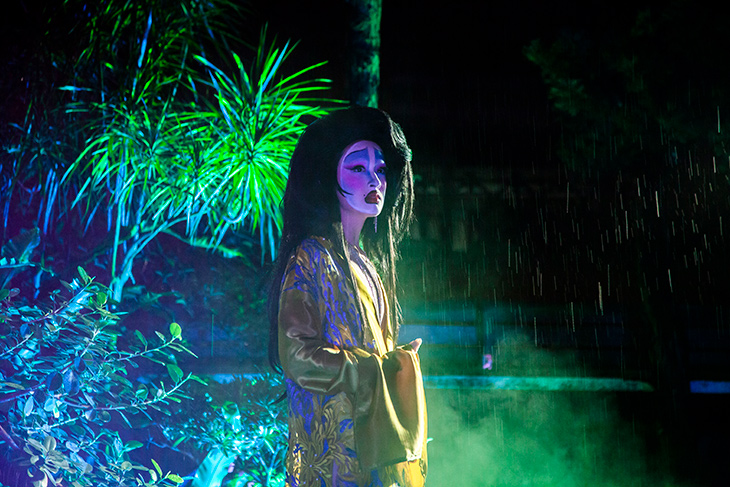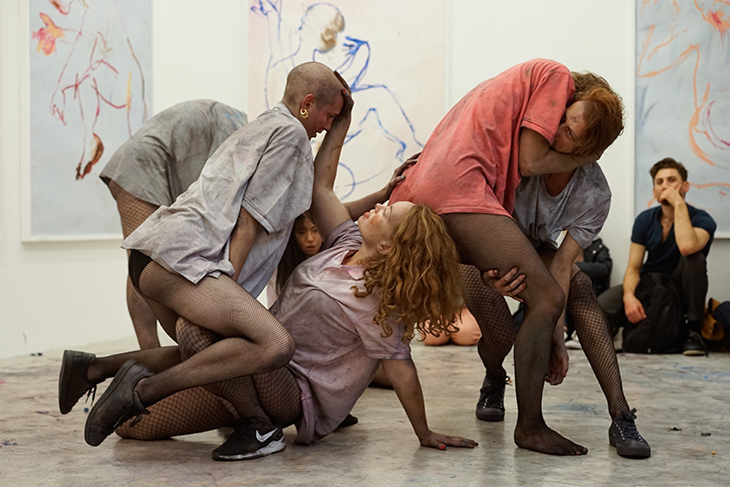At this year’s Venice Biennale there will be, for the first time, a dedicated performance art programme. Co-curated by the Biennale’s artistic director Ralph Rugoff and Aaron Cezar of the Delfina Foundation in London, the programme allows performance to take its place alongside painting, sculpture, installation and film in one of the world’s most important contemporary art settings. The catch is that, although the Biennale runs from May to November, the performances will only happen in the opening week and final weekend.
The trouble with performance is that it flips everything around in terms of cost. Shipping a painting is a one-time expense – and the longer you have that painting up on display, the better value for your money. Performance might not need shipping, storing, conserving or insuring in the same way. Instead, it requires people – who need daily pay, accommodation and food. The longer you have a performance on display, the more it costs you. This is one reason why performance is often restricted to one-offs, opening nights, or becomes subject to the requirements of large-scale institutions that can sell hundreds of tickets.
One solution is to consider new models of supporting performance. The art market in particular can seem awash with ready money and yet, despite its ever-increasing presence in the art world, performance has only a nascent market. A large part of its appeal, for early adopters in the 1960s and ’70s, was as an art form – spontaneous, ephemeral – that could actively evade commercialisation. Often politically agitating and physically punishing, it relied on experimental and peer-led contexts – domestic spaces turned temporary venues, abandoned warehouses and industrial wastelands – as opposed to museums and galleries. To some, performance today remains the last bastion of an art world outside the ‘corrupting’ and ‘corrosive’ influences of the marketplace.

If I had the words to tell you we wouldn’t be here now (2019), Victoria Sin. Performance at Chi-Wen Gallery, Taipei; a version will be staged at the 58th Venice Biennale. Photo: Ivy Tzai
Nevertheless, the effects of austerity and a decade of public funding cuts have meant the inevitable dissolution of boundaries between public and private money – and made the art market an ever more attractive place for artists of all kinds. It’s possible to see a number of ways through which performance artists might be supported in the market. None of this is without precedent – the histories of conceptual art and photography, film and video offer significant models for the circulation of art though documentation and ephemera. Modernists as far back as Marcel Duchamp used photography and film to capture images of performances – even if they didn’t always describe their work in those terms. Conceptual artists began offering collectors contracts and certificates in the 1960s as a way to facilitate economic exchange for their immaterial ideas and gestures. There are a number of artists working today, such as Theaster Gates, Oscar Murillo and Eddie Peake, who in parallel with their performance practice have turned to the traditional, tangible, and market-savvy medium of painting.
To create a market for performance itself, however, means understanding that each performance has unique requirements and so each purchase of a performance will look different. Research conducted by the Tate has led the way in this regard, with projects such as ‘The Live List’ offering practical guidance in acquiring performance. One of the things The Live List highlights is how every performance requires a bespoke acquisition framework. This is both what is exciting about collecting performance, and prohibitive to many.

Improvisation, Touch Horizontal Pleasure (2017), Florence Peake. Performance at Bosse & Baum, London (performers: Katya Coe, Iris Chan, Rachel Gildea, Lizzy Le Quesne, Eve Stainton, Rosalie Wahlfrid). Photo: Anna Tetzlaff. Courtesy the artist and Bosse & Baum
Many commercial galleries are already taking this challenge on, working with estates and archives as well as practicing artists. Lisson Gallery, which when it first opened in 1967 was a pioneering platform for conceptual artists, now works with leading exponents of performance art such as Marina Abramović and Ai Weiwei as well as a younger generation that includes figures like Laure Prouvost, for whom performance is but one part of an expansive oeuvre. Younger galleries such as Arcadia Missa, Vitrine, Seventeen, Arcade, and Bosse and Baum to name a few are all also doing a lot of work with this emerging generation.
Still, the art market remains heavily skewed towards painting and in reality can only support a small minority of the artists working today. The case for public funding of the arts must continue to be made – not because the market is bad but because it can only ever be one part of a healthy ecosystem. Just like painters or sculptors, performance artists still need space to create experimental, risky projects without having to consider commercial demands – as well as the projects that are intimate, quiet or otherwise unsuited to large museums and audiences. Collectors should be encouraged to support the whole gamut of contemporary practice, but to simply ask performance to fit into the existing market structures is to follow a logic that risks wringing out any remaining critical agency that art has.
Rose Lejeune is an independent curator and researcher.

Performance art costs a lot to produce – but can it make money, too?
Seeking After the Fully Grown Dancer *deep within* (2016–2018), Paul Maheke. A version of this performance will be staged at the 58th Venice Biennale. Photo: Sandino Scheidegger
Share
At this year’s Venice Biennale there will be, for the first time, a dedicated performance art programme. Co-curated by the Biennale’s artistic director Ralph Rugoff and Aaron Cezar of the Delfina Foundation in London, the programme allows performance to take its place alongside painting, sculpture, installation and film in one of the world’s most important contemporary art settings. The catch is that, although the Biennale runs from May to November, the performances will only happen in the opening week and final weekend.
The trouble with performance is that it flips everything around in terms of cost. Shipping a painting is a one-time expense – and the longer you have that painting up on display, the better value for your money. Performance might not need shipping, storing, conserving or insuring in the same way. Instead, it requires people – who need daily pay, accommodation and food. The longer you have a performance on display, the more it costs you. This is one reason why performance is often restricted to one-offs, opening nights, or becomes subject to the requirements of large-scale institutions that can sell hundreds of tickets.
One solution is to consider new models of supporting performance. The art market in particular can seem awash with ready money and yet, despite its ever-increasing presence in the art world, performance has only a nascent market. A large part of its appeal, for early adopters in the 1960s and ’70s, was as an art form – spontaneous, ephemeral – that could actively evade commercialisation. Often politically agitating and physically punishing, it relied on experimental and peer-led contexts – domestic spaces turned temporary venues, abandoned warehouses and industrial wastelands – as opposed to museums and galleries. To some, performance today remains the last bastion of an art world outside the ‘corrupting’ and ‘corrosive’ influences of the marketplace.
If I had the words to tell you we wouldn’t be here now (2019), Victoria Sin. Performance at Chi-Wen Gallery, Taipei; a version will be staged at the 58th Venice Biennale. Photo: Ivy Tzai
Nevertheless, the effects of austerity and a decade of public funding cuts have meant the inevitable dissolution of boundaries between public and private money – and made the art market an ever more attractive place for artists of all kinds. It’s possible to see a number of ways through which performance artists might be supported in the market. None of this is without precedent – the histories of conceptual art and photography, film and video offer significant models for the circulation of art though documentation and ephemera. Modernists as far back as Marcel Duchamp used photography and film to capture images of performances – even if they didn’t always describe their work in those terms. Conceptual artists began offering collectors contracts and certificates in the 1960s as a way to facilitate economic exchange for their immaterial ideas and gestures. There are a number of artists working today, such as Theaster Gates, Oscar Murillo and Eddie Peake, who in parallel with their performance practice have turned to the traditional, tangible, and market-savvy medium of painting.
To create a market for performance itself, however, means understanding that each performance has unique requirements and so each purchase of a performance will look different. Research conducted by the Tate has led the way in this regard, with projects such as ‘The Live List’ offering practical guidance in acquiring performance. One of the things The Live List highlights is how every performance requires a bespoke acquisition framework. This is both what is exciting about collecting performance, and prohibitive to many.
Improvisation, Touch Horizontal Pleasure (2017), Florence Peake. Performance at Bosse & Baum, London (performers: Katya Coe, Iris Chan, Rachel Gildea, Lizzy Le Quesne, Eve Stainton, Rosalie Wahlfrid). Photo: Anna Tetzlaff. Courtesy the artist and Bosse & Baum
Many commercial galleries are already taking this challenge on, working with estates and archives as well as practicing artists. Lisson Gallery, which when it first opened in 1967 was a pioneering platform for conceptual artists, now works with leading exponents of performance art such as Marina Abramović and Ai Weiwei as well as a younger generation that includes figures like Laure Prouvost, for whom performance is but one part of an expansive oeuvre. Younger galleries such as Arcadia Missa, Vitrine, Seventeen, Arcade, and Bosse and Baum to name a few are all also doing a lot of work with this emerging generation.
Still, the art market remains heavily skewed towards painting and in reality can only support a small minority of the artists working today. The case for public funding of the arts must continue to be made – not because the market is bad but because it can only ever be one part of a healthy ecosystem. Just like painters or sculptors, performance artists still need space to create experimental, risky projects without having to consider commercial demands – as well as the projects that are intimate, quiet or otherwise unsuited to large museums and audiences. Collectors should be encouraged to support the whole gamut of contemporary practice, but to simply ask performance to fit into the existing market structures is to follow a logic that risks wringing out any remaining critical agency that art has.
Rose Lejeune is an independent curator and researcher.
Unlimited access from just $16 every 3 months
Subscribe to get unlimited and exclusive access to the top art stories, interviews and exhibition reviews.
Share
Recommended for you
‘It’s a record of my life, translated into art’
An interview with Joan Jonas, on the occasion of the artist’s major retrospective at Tate Modern
Please stop calling celebrities performance artists – they really aren’t
It’s time to stop using the art form to justify the attention-seeking antics of figures such as Shia LaBeouf and Kanye West
Where is performance’s place in museum collections?
Museums are waking up to its potential, and its challenges